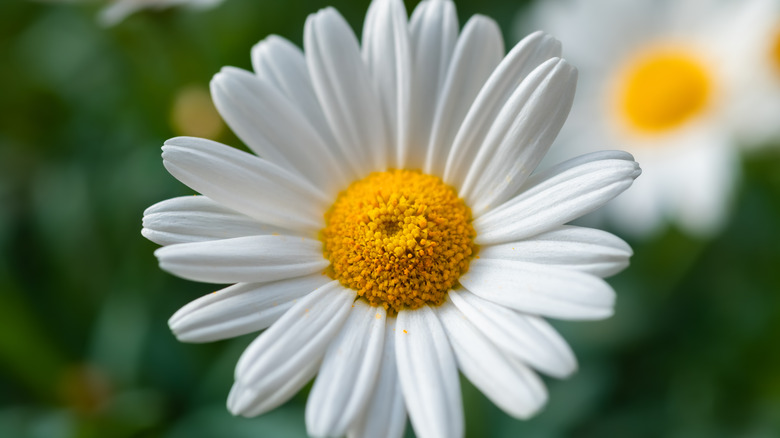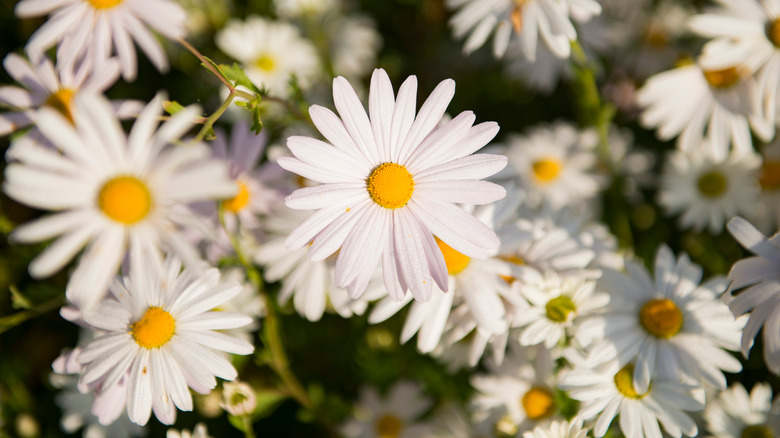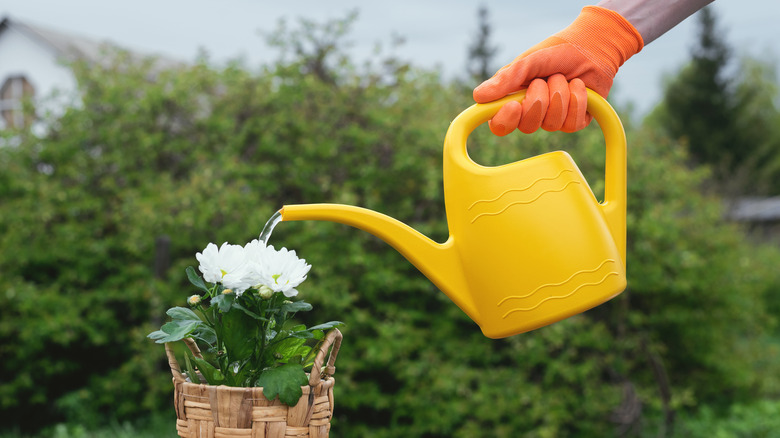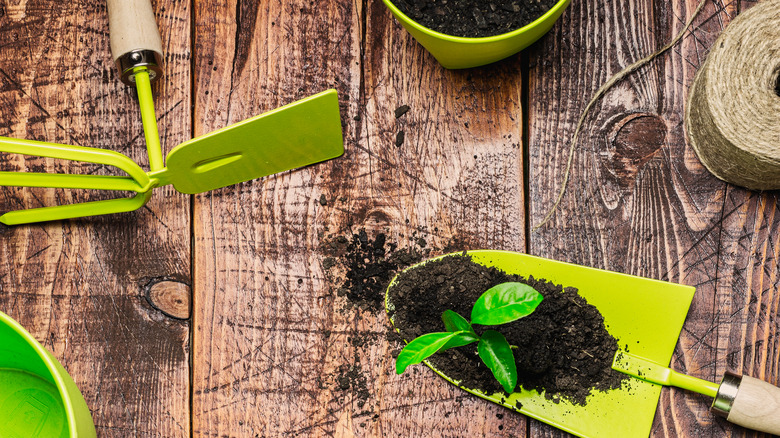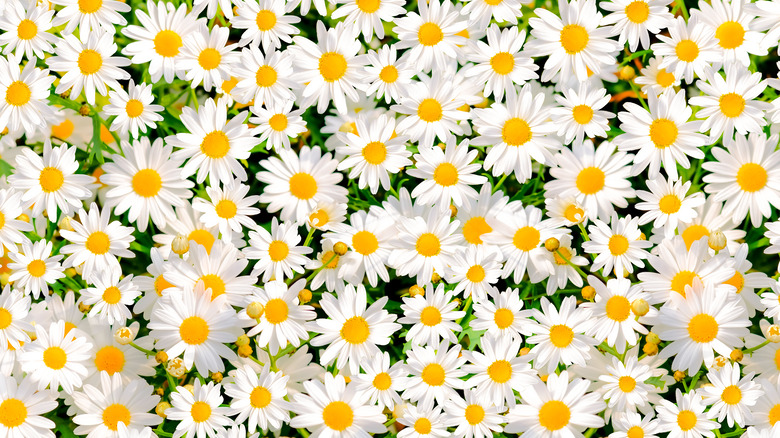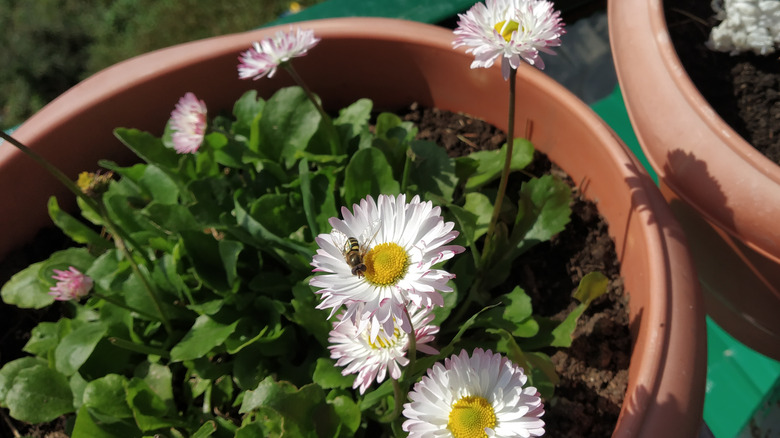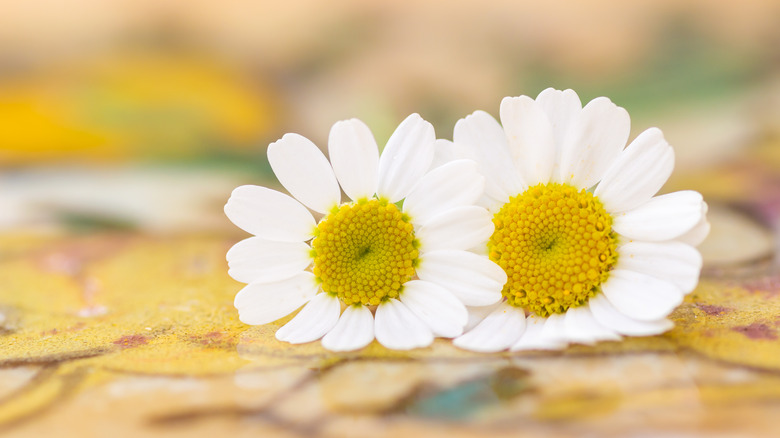How To Care For Shasta Daisy Plants
The shasta daisy (scientific name: Leucanthemum x superbum) is a flowering plant native to Europe and Asia and known for attracting butterflies and bees. Named for Mount Shasta, a Northern California volcano that last erupted in 1250, shasta daisies can grow to a dainty 8 inches tall or, depending on variety, as high as 4 feet, says silive.com. The plant is a hybrid of ray florets (outer petals) and disk florets (that middle cap of yellow) which were bred by Luther Burbank in the late 19th century.
Shasta daisies are hardy plants that bloom in summer and, so long as you give them adequate sun and well-draining soil, will come back every year for a repeat showing. They are pretty but not fragrant, and because of this, they were reclassified out of the Chrysanthemum family into the Leucanthemum genus.
In addition to their trademark white bloom with yellow disk middle, shasta daisies also grow a wide tuft of green leaves that stay low to the ground and make nice filler for a garden or landscape, says Gardening Know How. They are easy to care for, and their summer blooms make a nice cut bouquet that lasts up to a week in your vase plus encourages more prolific growth on the remaining plant. Keep reading for shasta daisy care and growing tips.
How to use shasta daisy plants in your garden
According to The Spruce, you will want to plant shasta daisies in early spring to get them going before the cold winter months. After that, these pretty flowers will bloom in summer and keep blooming into early fall, says Spoken Garden.
The shasta daisy looks great against the backdrop of an even taller blooming plant, like the bellflower, which can hit 6 feet in height, has similar sun and soil needs, and blooms its purple flower through the summer as well. Shasta daisies also look great with smaller border plants, like a petunia. The white shasta daisies would set off the purples, blues, or pinks of the petunia plant, which also has the same easy draining soil needs as the shasta daisy.
When planning how to use shasta daisies in your garden, make room for them to grow up to 4 feet tall in a clump of evergreen that can spread into as much as 2 feet wide. Their appealing flowers of white petals with a yellow center go well with lots of other colorful plants. SFGate suggests you simply pick companion plants that enjoy full sun and only need watering when your area is getting less than an inch of rain a week. Also, no need to worry about these plants affecting your pets. Although some daisies are toxic to dogs and cats, Love Your Dog reports that the shasta daisy is not one of them.
How to grow shasta daisy plants
For potted shasta daisies, gently press seeds into your easy-drain soil without covering them completely, says Gardener's Path. Position your pot in a bright sunny spot. Consider three or four seeds in each pot. Water enough to keep the soil moist, but not wet with pooling water as shasta daisies prefer dry to overwatering.
The Gardening Cook recommends planting outdoor shasta daisies in full sun to light shade, starting with an easy-drain soil that you have lightly watered and starter shasta daisies that you can buy at most garden centers (if starting from seeds, blooms will not appear until the following year). Dig your hole twice the size of your starter shasta daisy container, and make sure your root ball peeks out at the soil level, keeping your holes at least 2 feet apart if you are planting multiples. Gardener's Path suggests giving the soil a dusting of shredded bark mulch in the spring to minimize weeds.
Plant shasta daisies in your outside garden after any threat of frost in the early spring, says Garden Design. A nice layer of compost is recommended every spring, says Gardeners Path. It keeps the soil rich to help your shasta daisies optimally grow. However, steer clear of fertilizing since that nitrogen can begin to undermine your blooms, says MasterClass. With these tactics, they suggest that you should begin to see new sprouts within two weeks.
How to care for shasta daisy plants
Shasta daisies are drought-tolerant, so plan to water weekly, but first check that your soil is getting drained and dry before watering again, says MasterClass. They recommend adding sand or peat moss if your soil needs loosening to dry out faster. In late fall, trim your shasta daisy stems down to the leaves; then, when winter comes, cut them all the way down to a few inches above the ground. The blooms will develop again after the dormant winter season.
Should you notice your plants begin looking weighed down by their own burgeoning blooms, you may want to stake your shasta daisy, according to Garden Design. Better Homes & Gardens walks you through that process, which involves driving your stake into the ground next to your shasta daisy and tying its stem to your stake with twine.
Aside from occasional deadheading and pulling faded plants up from the stem, silive.com says that shasta daisies need little dividing to propagate. They multiply via their own root system, which sprouts horizontally underground with mini root shoots that germinate new buds and help grow a gardener's dream clump of shasta daisy blooms. However, if you notice your shasta daisies are getting fewer and fewer blooms, that is a sign to manually divide them, says Burpee.
Varieties of shasta daisy plants
The shasta daisy (scientific name: Leucanthemum x superbum) was named by Luther Burbank in 1901 after he crossbred the oxeye daisy (Leucanthemum vulgare), English field daisy (Leucanthemum maximum), and Portuguese field daisy (Leucanthemum lacustre) says Garden Design. It is part of the Asteraceae family and the Leucanthemum genus, which are native to Europe and Asia, according to Gardener's Path.
Here are five examples of unique shasta daisies:
- Banana cream – a yellow daisy! This plant blooms a similar petal and disk flower as the daisy that traditionally comes to mind, but its petals are pale yellow against its pop of yellow center.
- Becky – this plant blooms big. Its flowers grow to 4 inches around on stems that can grow to 4 feet.
- Crazy daisy – this plant has traditional white daisy petals with a crazy twist. Its blooms have a dark yellow center with lots of feathery petals layered on top of each other.
- Snow lady – this plant looks like a traditional daisy, but a small one. It tops out around 12 inches tall.
- Double forms – according to Savvy Gardening, this plant is something like the crazy daisy that features lots of layers of petals but less crazy. Double forms looks like a traditional daisy, but with two layers of the iconic white petals.
How to repot shasta daisy plants
To repot your shasta daisy, Gardening Know How suggests you start by pulling your plant from its current pot, crumble off excess dirt, then use a sharp gardener's tool to split it at the root ball. You can divide a root ball into as many as four pieces, then plant each in a new pot with easy drain soil. Although shasta daisies are drought-resistant plants, steer clear of terra cotta pots that might dry the plant too much. Stick with plastic or glazed pots. Water well after repotting, then regularly after that when the top inch of soil gets dry.
Outdoor shasta daisies will propagate on their own by way of their rhizome root system, says silive.com. However, if you are wishing to manually expand your shasta daisies, you can simply replant seeds or stems from your current shasta daisies, says GardenerScott.
To gather seeds, wait to deadhead a few dying daisies until their petals dry, then store them in a paper bag for a week before squeezing out their seeds. If you rather propagate by cuttings, you can slice a 6-inch long stem from your current shasta daisy cluster and plant that into a pot of garden soil, making sure it is damp and has indirect sunlight until its roots take. If you keep it moist but not wet, it should be ready to be planted in your garden within a few weeks.
Plant information specific to shasta daisies
Shasta daisies' flat bloom makes a perfect landing platform for birds, butterflies, and pollinating bees. They also have that middle disk that is bright yellow – a favorite color among pollinators, says Savvy Gardening. The nectar in shasta daisies is also enticing to ladybugs and lots of other helpful insects that eradicate the pesky ones.
Although other flowers can claim pollinator-attracting nectar, very few can fall asleep at night like the shasta daisy. According to Freytag's Florist, shasta daisies close their petals at night over their yellow disk, revealing the lower part of their white petals. It is suggested this is due to light and temperature and responsible for the daisy moniker, which means "day's eye." ScienceDaily also suggests their nighttime rest is to reveal the underbelly of their white petals, which makes it tougher for predators to see them at night.
As if that wasn't unique enough, daisies also have been pegged the flower worthy of the love-me, love-me-not petal plucking ritual of yore. According to RB Plant, that hails back to Margaret of Provence, who pulled and prayed over each petal in 1248 for her husband, the king, who was off to war. Interestingly, daisy petals are more often odd than even, which makes a positive outcome more likely. Follow these tips to keep your shasta daisies thriving for years.
